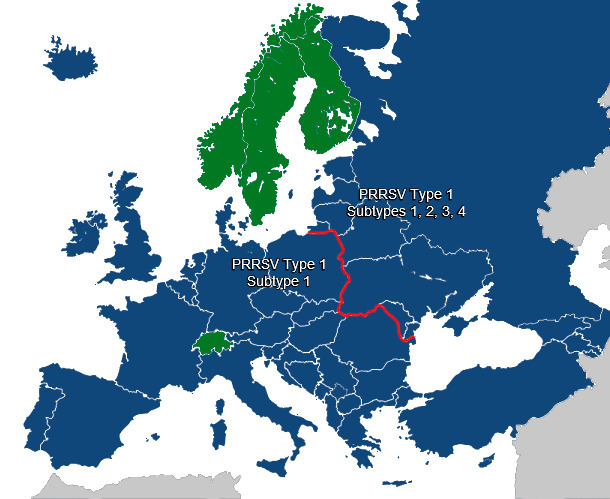Based on retrospective serological surveys the first evidence of PRRSV comes from 1987, from the former German Democratic Republic (GDR) (Ohlinger et al., 2000). The first clinical outbreaks were reported in Europe in November 1990 in Germany, with outbreaks in the Netherlands, Spain, UK, France, Belgium and Denmark occurring through 1991-1992 (OIE, 1992). Soon the disease was described in most of the European countries.
Originally, it was thought that the European strains of PRRSV (PRRSV Type 1) are all closely related, but recent studies have demonstrated that East European countries (Lithuania, Latvia, Belarus, Ukraine) and Russian Federation harbour exceptionally diverse PRRSV Type 1 strains (Stadejek et al., 2013). In those countries as many as four distinct genetic subtypes are present, while in Western and Central Europe only a single genetic subtype was detected. That Western European genetic subtype 1 is also present in North America and South East Asia. There seems to be a sharp geographical demarcation of PRRSV diversity in Europe, along the Polish eastern border. The subtype 1 viruses were only detected west of the border, and east of the border the subtypes 1, 2, 3 and 4 (and likely more) are present.


We currently believe that political and trade barriers are most likely explanation of this virus diversity pattern. The currently available sequences place the most recent common ancestor of PRRSV Type 1 strains between 1946-1967, ie, during the post-World War II development of Europe (Forsberg, unpublished results), and at least 20 years before the first signs of the presence of this virus in Western Europe. In the former Soviet Union, this period involved massive geographical movement of pigs from Western Europe (Large White, Middle White, Danish Landrace, Berkshire), from countries incorporated to the Soviet Union (Lithuanian and Latvian Whites), and from different parts of Russia (Asian part: Siberian, North Siberian, Siberian Black Pied, Kemerovo and Semirechensk breeds; European part: Chuvash, Kuban, North Caucasus and Urzhum breeds) resulting in new genetic lines of pigs. It seems plausible that the post-war expansion of the former Soviet Union and breeding programs created an environment allowing a new virus to emerge, or an already emerged virus to spread. Also, because Poland and other Central European countries were much less influenced by these policies than for example Belarus, Ukraine and the Baltic states, it seems plausible that if new PRRSV subtypes arose during the post-war upheavals, they would be dominant in the countries formerly being part of the Soviet Union, but not necessarily in the countries of the former Communist Block, not being part of the Soviet Union.
Still, the question on how PRRSV spread in western part of Europe remains open. PRRSV may have spread to West Europe from East Germany (former GDR) (Ohlinger et al., 2000). The evidence exists that new pig breeds were produced in GDR by crossbreeding with Soviet pig breeds. One of the products of such crossbreeding was east German Large White established in 1954 composed of German Large White, Russian Large White and Hungarian Large White with introgression of Latvian Large White and Hungarian Yorkshire in 1980. Interestingly this East German breed was formally included in the west German Large White breed in 1993.
The great genetic diversity of East European strains has practical implications. Several independent studies have proved that Belarusian strains from the genetic subtype 3 (e.g. Lena strain) are significantly more virulent than any other strain from Western European subtype 1 (Karniychuk et al. 2010; Morgan et al., 2013). Some experiments suggested that those strain can be as pathogenic as highly pathogenic PRRS strains from China. The genetic diversity of the East European strains poses a real problem for the sensitivity of PCR diagnostic methods, as the common target regions for PCR primers (ORF7) are highly genetically diverse in those strains, so the sensitivity of some of the diagnostic PCR methods can be compromised (Wernike et al. 2012). Also, the efficacy of the current PRRSV vaccines against the East European genetic variants still needs to be elucidated.






